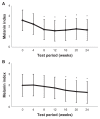Oral administration of French maritime pine bark extract (Flavangenol(®)) improves clinical symptoms in photoaged facial skin
- PMID: 22956863
- PMCID: PMC3426262
- DOI: 10.2147/CIA.S33165
Oral administration of French maritime pine bark extract (Flavangenol(®)) improves clinical symptoms in photoaged facial skin
Abstract
Background: French maritime pine bark extract (PBE) has gained popularity as a dietary supplement in the treatment of various diseases due to its polyphenol-rich ingredients. Oligometric proanthocyanidins (OPCs), a class of bioflavonoid complexes, are enriched in French maritime PBE and have antioxidant and anti-inflammatory activity. Previous studies have suggested that French maritime PBE helps reduce ultraviolet radiation damage to the skin and may protect human facial skin from symptoms of photoaging. To evaluate the clinical efficacy of French maritime PBE in the improvement of photodamaged facial skin, we conducted a randomized trial of oral supplementation with PBE.
Methods: One hundred and twelve women with mild to moderate photoaging of the skin were randomized to either a 12-week open trial regimen of 100 mg PBE supplementation once daily or to a parallel-group trial regimen of 40 mg PBE supplementation once daily.
Results: A significant decrease in clinical grading of skin photoaging scores was observed in both time courses of 100 mg daily and 40 mg daily PBE supplementation regimens. A significant reduction in the pigmentation of age spots was also demonstrated utilizing skin color measurements.
Conclusion: Clinically significant improvement in photodamaged skin could be achieved with PBE. Our findings confirm the efficacy and safety of PBE.
Keywords: antiaging; antioxidants; pine bark extract; polyphenols; skin photoaging.
Figures






References
-
- Masquelier J, Michaud J, Laparra J, Dumon MC. Flavonoids and pycnogenols. Int J Vitam Nutr Res. 1979;49(3):307–311. - PubMed
-
- Hammerstone JF, Lazarus SA, Mitchell AE, Rucker R, Schmitz HH. Identification of procyanidins in cocoa (Theobroma cacao) and chocolate using high-performance liquid chromatography/mass spectrometry. J Agric Food Chem. 1999;47(2):490–496. - PubMed
-
- Cansfield PE, Marquardt RR, Campbell LD. Condensed proanthocyanidins of fababeans. J Sci Food Agric. 1980;31(8):802–812. - PubMed
Publication types
MeSH terms
Substances
LinkOut - more resources
Full Text Sources
Medical

